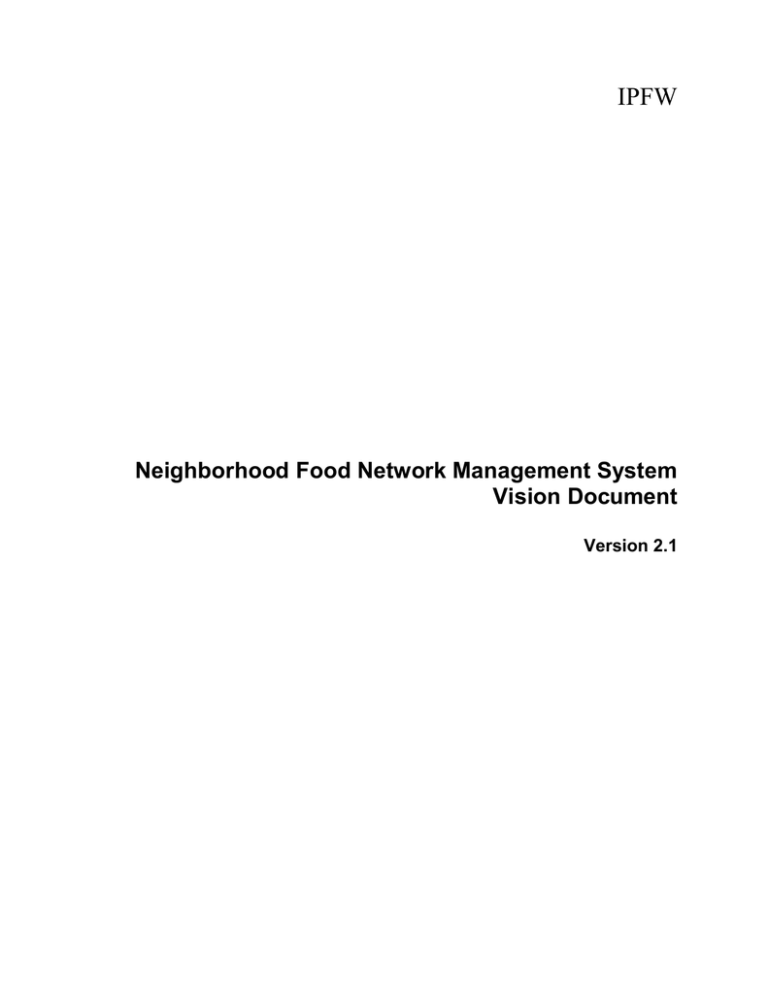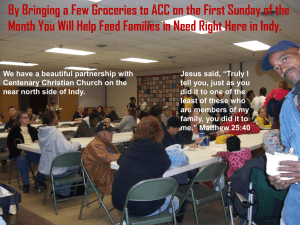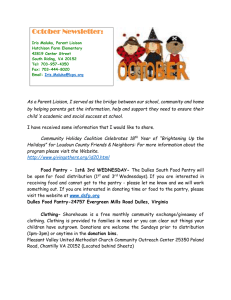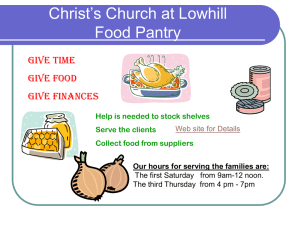IPFW Neighborhood Food Network Management System Vision Document
advertisement

IPFW Neighborhood Food Network Management System Vision Document Version 2.1 Associated Churches Food Network Management System Vision NFNMS-Vision Version: 2.1 Date: 08/15/2011 Revision History Date Version Description Author 07/15/2011 1.0 Initial draft. R. L. Sedlmeyer 08/03/2011 2.0 Updated User Environment and Product Overview and Product Features sections based on visits to three local food pantries. R. L. Sedlmeyer 08/15/2011 2.1 Added descriptions of warehouse and main office operations to User Environment and Product Overview section. R. L. Sedlmeyer Confidential IPFW, 2016 Page 2 Associated Churches Food Network Management System Vision NFNMS-Vision Version: 2.1 Date: 08/15/2011 Table of Contents 1. 2. 3. 4. 5. Introduction 4 1.1 4 References Positioning 4 2.1 2.2 Problem Statement Product Position Statement 4 5 Stakeholder and User Descriptions 5 3.1 3.2 3.3 3.4 5 5 6 9 Stakeholder Summary User Summary User Environment Summary of Key Stakeholder or User Needs Product Overview 10 4.1 4.2 10 11 Product Perspective Assumptions and Dependencies Product Features Confidential 11 IPFW, 2016 Page 3 Associated Churches Food Network Management System Vision NFNMS-Vision Version: 2.1 Date: 08/15/2011 Vision 1. Introduction This document defines the vision for a web application to support the supplying and monitoring of the Associated Churches (AC) Neighborhood Food Network. AC supplies 28 food pantries in Allen County. These pantries are located in churches and other community service buildings. AC provides food to the pantries. In some cases they provide all of the food and in others they provide as little as 10%. The pantries are able to order food on a periodic basis. They are asked to provide demographic information on the people they serve. Very little technology is currently in use in this operation. AC would like to develop a web application that enables them to improve their understanding of the population being served and to partially automate some of the current processes for supplying these food pantries. 1.1 References 1. 2. 3. 4. 5. Associated Churches Food Pantry Intake Form Associated Churches Food Pantry Request Form Associated Churches Emergency Food Bank System Monthly Report Form (Word document) Associated Churches Emergency Food Bank System Monthly Report for _______ (Excel spreadsheet) 2010 Totals by Food Banks and Feeding Sites 2. Positioning 2.1 Problem Statement The problem of affects the impact of which is a successful solution would be paper-based, manual processes for supplying and monitoring food pantries, which are part of the Associated Churches Neighborhood Food Network ministry, to ensure equitable distribution of limited food resources those individuals and families who are served by the ministry and those volunteers and Associated Churches staff who participate in the ministry inefficient use of volunteer hours, redundant recording of data, difficulty in assessing ministry operations, and inability to detect violations of food pantry guidelines automating a subset of these processes to collect and organize relevant data from all food pantries into a central repository resulting in (1) more accurate accounting of the families and individuals served by the Neighborhood Food Network ministry; (2) easier detection and reporting of violations of eligibility guidelines; (3) easier preparation of monthly and annual reports; and (4) greater accessibility to individual and aggregate food pantry data; Confidential IPFW, 2016 Page 4 Associated Churches Food Network Management System Vision NFNMS-Vision Version: 2.1 Date: 08/15/2011 (5) increased confidence that Associated Churches is a good steward of monetary and food donations received to support this ministry; and (6) better awareness of the degree to which the Neighborhood Food Network is fulfilling its mission. 2.2 Product Position Statement For Associated Churches Who desires a web-based system to monitor operations of their Neighborhood Food Network is a web application The Neighborhood Food Network Management System That enables recording and reporting of essential food pantry client and organizational data comprehensive food pantry management software products Unlike Our product provides basic features with special attention to usability and requires little or no additional investment in hardware or software 3. Stakeholder and User Descriptions 3.1 Stakeholder Summary Stakeholders who are also users are described in Section 3.2. 3.2 Name Description Responsibilities Food Pantry Client A person who requests food from a food pantry supplied by Associated Churches. This stakeholder is concerned with how the system will aid them in obtaining their fair share of limited food provided by their local pantry. Donor A person or organization that provides funds or food to the Associated Churches Food Ministry. This stakeholder is concerned with how the system will better ensure (1) the accountability of any funds donated and (2) the equitable distribution of food donated or purchased. Name Description Responsibilities Executive Pastor The person who oversees the Neighborhood Food Network ministry. Prepares budget. Prepares annual report to donors. Coordinates work of Warehouse Manager and Operations Manager. User Summary Confidential IPFW, 2016 Page 5 Associated Churches Food Network Management System Vision NFNMS-Vision Version: 2.1 Date: 08/15/2011 Communicates with Food Pantry Directors. 3.3 Food Pantry Director A person who oversees the operation of a food pantry. Records details of food donations. Records details of dollars spent. Tracks volunteer hours. Prepares “Food Pantry Request Form”. Prepares “Food Bank System Monthly Report Form”. Food Pantry Volunteer A person who assists clients in obtaining food from a food pantry. Fills-in “Food Pantry Intake Form” for new client. Checks for existing intake form for repeat client. Determines eligibility of client. Warehouse Manager The person who manages the Associated Churches warehouse. Reviews “Food Pantry Request Form”. Records details of order-fulfillment on “Food Pantry Request Form”. Transfers data from “Food Pantry Request Form” to existing database application. Occasionally prepares “Food Pantry Request Form” for food pantries with well-known needs. Operations Manager The person who works closely with the Executive Pastor to ensure smooth operation of the Neighborhood Food Network. Aggregates monthly reports submitted by each food pantry. User Environment Local Food Pantry Operations. The following description of the user environment for local food pantry operations is a synthesis of information obtained during visits to three food pantries with Alan Buck. Food pantry operations are typically located in a building that serves multiple purposes. Each food pantry is divided into three physical areas: client check-in, waiting, and food distribution. The food distribution area is permanently assigned to a separate room with limited access. The check-in and waiting areas are temporarily set-up within a larger room or hallway. The check-in area is furnished with a table and one or two chairs for the food pantry volunteers. The waiting area has limited seating; some clients may have to stand while awaiting food distribution. Depending on day and time, there may be a long waiting line for both check-in and food distribution. One or two volunteers staff the check-in table. Two or more volunteers staff the food distribution area. No computer equipment is utilized; all information is recorded on forms provided by Associated Churches or on ad hoc forms, e.g. 3” x 5” Confidential IPFW, 2016 Page 6 Associated Churches Food Network Management System Vision NFNMS-Vision Version: 2.1 Date: 08/15/2011 cards, created by each food pantry. Task descriptions and sequencing associated with check-in and food distribution are as follows. 1. Client presents identification (driver’s license, utility bills). This task may take several minutes since there are a wide variety of identification artifacts that may be presented and the check-in Volunteer must ensure that they are valid and current. 2. Volunteer checks eligibility. All food pantries allowed Clients to obtain food even if they were not eligible. Clients were reminded of eligibility requirements. a. Does Client live within geographical boundaries of food pantry? Some volunteers referred to maps supplied by Associated Churches to determine if Client address was within boundaries. Others knew the area well enough to do this based on address alone. In either case, this task takes at most a minute or two. b. Has client already received food from the pantry during the current month? Most food pantries kept some kind of log that maintained a history of Client visits. At least one food pantry did this by simply remembering if the Client had been there recently. This task takes no more than a minute to perform. 3. Client fills out Food Pantry Intake Form and returns it to check-in Volunteer. At this time, some Volunteers complete bottom portion of form. Client may spend 10 minutes or more to fill out form. Some Clients, who may not read or write English, are assisted by a check-in Volunteer. In this case, the task may take longer. 4. Volunteer reviews form, verifying that all required information is present. This task takes less than a minute unless information is missing. 5. Volunteer logs visit. At a minimum the log included Client name, address, family size and date of visit. Other information recorded might include gender and racial category. Log entries used to facilitate creation of Food Bank System Monthly Report. 6. Client proceeds to waiting area. Each food pantry has a specific way to ensure that Clients are served in the order they arrive. 7. Volunteer assists Client in obtaining food items based on availability and food pantry policies. This task varies widely from pantry to pantry. One pantry had prepackaged all food into grocery bags and simply handed them to Clients. Another pantry allowed Clients to scan shelves and request individual food items. At a third pantry, a Volunteer walked through all food shelves with the Client, making suggestions. Times to complete this task vary widely depending not only on the process adopted by the food pantry, but on the decision process of individual Clients. 8. Client returns form to check-in Volunteer for filing. If not already completed, Volunteer completes bottom portion of form. Other activities performed at each local food pantry include ordering and preparing a monthly report. No observations were made of the ordering process; however, from conversations with the Volunteers three approaches to ordering were described: (1) No ordering. It was assumed that the Warehouse knew what was needed and the food pantry accepted and utilized whatever was sent. (2) Infrequent ordering. Due to difficulties in matching food needs with warehouse inventory (don’t get what is ordered, receive what is not needed, receive outdated food items), food pantry seldom utilizes order form. Instead, Volunteers go to Warehouse and select food items. Confidential IPFW, 2016 Page 7 Associated Churches Food Network Management System Vision NFNMS-Vision Version: 2.1 Date: 08/15/2011 (3) Ordering based on inventory. Volunteers took careful inventory of food items and ordered accordingly using the Food Pantry Request Form. This form of ordering is commonly done on a weekly or semi-weekly basis. Order forms are submitted via fax or email. Sometimes, the requests themselves are made informally in email messages. As with ordering, no observations were made of the preparation of the monthly report. Again, based on conversations with Volunteers the following tasks are performed. (1) Client Demographics. These data may come from pantry-specific artifacts such as daily logs and 3” x 5” cards in addition to the standard check-in forms. Often, subtotals are calculated for each day the pantry is opened, making it easier to determine the monthly totals. (2) Volunteer Data. These data include the total number of Volunteers and estimated Volunteer hours. These totals are determined from Volunteer sign-in sheets or monthly schedules maintained by the Director. (3) Other Food Donations & Dollars Spent. Each food or monetary donation is recorded in a log maintained by the Director. These are then transferred to the monthly report form. Warehouse Operations. The following description of the user environment for warehouse operations is based on information obtained during a tour of the Associated Churches Warehouse and interview with Mr. Chris Alvarez, the warehouse manager. The warehouse, which is part of the Associated Churches downtown office complex, serves as the distribution point for all food supplied by the Associated Churches Neighborhood Food Network. It is a large building with a loading dock capable of handling tractor trailers, small office, several aisles with large capacity shelving units, and a large refrigeration unit for perishable food items. There are spacious floor areas set aside for sorting and order fulfillment. A single manager coordinates all activities within the warehouse. Volunteers aid in sorting food items received and in placing food items onto shelves or cartons with predefined contents. Task descriptions and sequencing associated with ordering, the main focus of this project, are as follows. 1. 2. 3. 4. 5. 6. 7. 8. Warehouse manager receives order form. An average of five forms is received each day. Most come via fax. Some are emailed and a few may be delivered in person. Warehouse manager enters information from order form into custom database application. Individual food item requests are aggregated by database application. Warehouse manager checks inventory. Three situations may arise: a. Inventory is sufficient to satisfy all requests. b. Inventory is not sufficient to satisfy all requests. In this case, allocation of available food items is based on past history, with pantries who did not receive all requested items most recently given preference. The exact procedure for doing this allocation was not articulated, but is based on the warehouse manager’s detailed knowledge of ordering history. c. A specific food item is not available. In this case, the warehouse manager may substitute a related item based on his judgment of the best match. Warehouse manager, possibly with help from volunteers, picks and packages food items for delivery. Warehouse manager indicates on order form what food items were actually supplied. Warehouse manager transfers information from updated order form to database application. Warehouse manager files completed order forms. Filing is done on a monthly basis. Confidential IPFW, 2016 Page 8 Associated Churches Food Network Management System Vision NFNMS-Vision Version: 2.1 Date: 08/15/2011 Main Office Operations. The following description of the user environment for main office operations is based on information obtained during a meeting with Rev. Roger Reece, Executive Pastor, and Ms. Elaine Williamson, Administrative Assistant. The main offices of Associated Churches are housed in a modern office building. The offices are well lit and spacious. Both the Executive Pastor and Administrative Assistant have desktop computers and are comfortable with the use of the internet and Microsoft Office applications. The primary task performed by the Administrative Assistant in supporting the Food Network is to record monthly food pantry reports in an Excel spreadsheet. Data from these spreadsheets are then aggregated to create annual data that is also maintained in an Excel spreadsheet. The Executive Pastor uses these annual data to prepare annual reports distributed to donors and other interested parties. 3.4 Summary of Key Stakeholder or User Needs Need Priority Current Solution Proposed Solutions Enforce pantry guidelines concerning frequency of client visits and geographic boundaries High (1) Rely on Volunteer knowledge of Client history and geographic boundaries (2) Manually look up client history (1) Automated look-up of Client history (2) Automated address location based on digitized map boundaries (3) Manually examine map to locate client address Identify pantry clients High (1) Request and examine id artifacts such as driver’s license and utility bills. (1) Request and examine id artifacts such as driver’s license and utility bills. (2) Direct Client to fill-in check-in form. (2) On-line look-up of Client information for returning Client. (3) Volunteer fills-in online checkin form using information supplied by Client. Capture data for annual donor reports High Track value/amounts of food items Medium Preparation of monthly report Medium Derive from monthly reports submitted by each local food pantry Automatically generate from stored monthly report data Derive manually from data recorded in daily logs Fill-out online form for all donations received. Automate Volunteer sign-in. Automatically generate from stored Confidential IPFW, 2016 Page 9 Associated Churches Food Network Management System Vision NFNMS-Vision Version: 2.1 Date: 08/15/2011 data on Clients, Volunteers and donations received. Facilitate ordering process Medium Manually fill out order form and submit via mail, email, phone or fax Fill out on-line form which may either be submitted via email or incorporated into current Warehouse db application Inform local pantries of special items & their availability Low Email Email and alerts on website Communicate to other pastors what services have been provided on what dates to what persons Low Ad hoc communication by email or word-of-mouth 4. Product Overview 4.1 Product Perspective A diagram of the proposed system is shown in Figure 1. Each local food pantry will have at least one computer with an attached printer. The computer will have an internet connection through which the Food Network Management web server and application are accessed. The application will require a login and all client- or organization-sensitive information will be encrypted. Volunteers will be restricted to accessing functions relevant to local food pantry operations. The Associated Churches office will have internet-enabled computers for all personnel who have responsibility for Food Network management and operators. This includes at least the Executive Pastor, Warehouse Manager and Operations Manager. These users will have access to system functions relevant to their role. The Server will host the web application and associated data repository. The data repository will store client and organizational information for all local food pantries and the warehouse. Such information includes client demographics, client visit history, volunteer hours, and food and monetary donations. Confidential IPFW, 2016 Page 10 Associated Churches Food Network Management System Vision NFNMS-Vision Version: 2.1 Date: 08/15/2011 Figure 1. Proposed Food Network Management System Architecture. 4.2 5. Assumptions and Dependencies Each food pantry will have at least one computer system with an Internet connection. A touch screen is recommended, but not required. The Associated Churches office will have a computer server connected to the Internet. A database management system must be installed on this server. Food pantry volunteers must have rudimentary computer skills and be willing to modify their processes to maximize the benefits of the proposed system. Product Features The Food Network Management System will have the following features: Client Management. Manages Clients’ information such as address, phone number, number in household, income level, and other demographic information. Provides familiar form for registration of new Client. Determines suitability of food pantry location based on Client address. Supports look-up of existing Client. Tracks where and when Clients have visited. Volunteer Management. Manages contact information about Volunteers (names, numbers, other contact information) and their work hours. Ordering. Provides familiar form for Volunteer to order food from Warehouse. Allows Warehouse Manager to review and modify order or examine order history for a given local food pantry. Aids in scheduling of food deliveries. Tracks how much food is delivered to each food pantry. Confidential IPFW, 2016 Page 11 Associated Churches Food Network Management System Vision NFNMS-Vision Version: 2.1 Date: 08/15/2011 Donations. Tracks source and number of pounds of each food donation. Tracks source and amount of each monetary donation. Reporting. Automatically generates monthly reports for individual food pantries and overall food network. Supports various queries for summarizing Client demographics, visits, food distribution and donations. Confidential IPFW, 2016 Page 12


